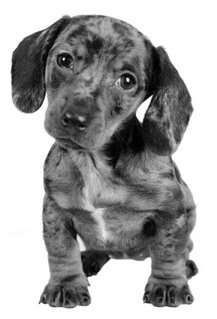Chihuahua or Great Dane? One Gene Sets Dog Size
By DONALD G. McNEIL Jr.
-------------------------------------------------------

If it weren’t for IGF-1, Paris Hilton’s life would be a lot less elegant.
She’d be lugging around an Irish wolfhound in her purse.
Scientists have just discovered which gene fragment controls the size of dogs, which have the greatest size range of any mammal — no other species produces adults with 100-fold differences, like that between a two-pound chihuahua and a 200-pound Newfoundland.
In a study to be published tomorrow in the journal Science, researchers analyzed 3,241 purebred dogs from 143 breeds. Genetically, the yapper arguing with your ankle is almost identical to the drooling behemoth bred to hunt bears, except for a tiny bit of DNA that suppresses the “insulin-like growth factor 1” gene.
Dog breeders have unwittingly been selecting for it since the last Ice Age. Dogs emerged from the wolf about 15,000 years ago, and as far back as 10,000 years ago, domesticated dogs as big as mastiffs and as small as Jack Russell terriers were trotting the earth.
The study’s lead author, Elaine A. Ostrander, chief of cancer genetics at the National Human Genome Research Institute, said she visited a lot of dog shows, asking for blood.
“It became kind of a status symbol to participate, and we were inundated,” she said. “I only wanted one sample from any descendant of one grandfather, and owners would show up with five Scottish deerhounds, all of them siblings, and say ‘oh, absolutely, they all want to be in.’”
Making it “cool biology,” she said, is that the same gene suppressor is found in both mice and men, creating mini-mice and suspected in human dwarfism.
And because it controls growth gone awry, she said, it will help cancer research, and is to be planted in mice.
But carefully: A mouse the size of a Great Dane, she said, “would be a little scary, wouldn’t it?”
-------------------------------------------------------
photo by: dane & dane photography


